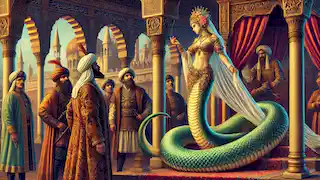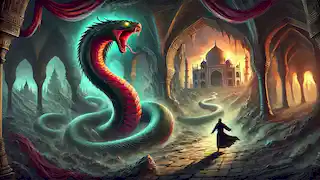In the heart of Anatolia, where the mountains meet the sky and the ancient rivers carve their paths through the rugged terrain, lies a legend that has been passed down through generations. This is the story of the Shahmaran, a tale of love, betrayal, and the mystical bond between a human and a creature of ancient lore. The Shahmaran, a being half woman and half serpent, reigns over the world of the Marans, a secret realm hidden deep beneath the earth. Her wisdom and beauty are unmatched, and her story is one that speaks of the delicate balance between trust and treachery, a lesson that has resonated through the ages. Long ago, in a small village nestled among the hills of Tarsus, there lived a young man named Cemşab. He was a simple man, the son of a poor woodcutter, who spent his days working in the forests, chopping wood to sell in the village market. Cemşab was known for his kind heart and gentle nature, always ready to lend a hand to those in need. But despite his humble life, he often dreamed of adventure and yearned for something more than the simple existence he had known. One day, while deep in the forest, Cemşab stumbled upon a cave he had never seen before. The entrance was partially hidden by thick vines and overgrown moss, as if it had been untouched for centuries. Intrigued, he pushed the vines aside and ventured inside, his curiosity piqued by the mysterious darkness that beckoned him further. The cave was cold and damp, and as he walked deeper, he felt an inexplicable sense of unease. Yet, something urged him to continue, as if an unseen force was guiding his steps. After what seemed like hours, Cemşab reached the end of the cave and found himself in a vast underground chamber. The walls glistened with moisture, and the air was thick with the scent of earth and stone. But what caught his attention most was the sight of a shimmering pool of water at the center of the chamber. The water was so clear that he could see the intricate patterns of the stones beneath the surface, each one glowing with an otherworldly light. As he approached the pool, Cemşab noticed something moving within the water. At first, he thought it was a trick of the light, but as he drew closer, he realized that it was a creature unlike anything he had ever seen. Rising from the water was the Shahmaran, her long, serpentine body coiled gracefully around the stones at the bottom of the pool. Her upper half was that of a beautiful woman, with flowing hair and eyes that gleamed like emeralds, while her lower half was that of a giant serpent, covered in scales that shimmered with iridescent colors. Cemşab was struck by her beauty and her presence, but he was also filled with fear. He had heard tales of the Shahmaran before, stories whispered by the elders around the village fires, but he had never believed them to be true. Now, standing before the legendary creature herself, he realized that the stories were more than just tales—they were a warning. To Cemşab's surprise, the Shahmaran spoke to him in a voice that was as soothing as the gentle flow of a stream. She welcomed him into her world and assured him that he had nothing to fear. She had seen the kindness in his heart and knew that he was different from others who had sought her out for their own gain. The Shahmaran told him that she had lived for centuries, guarding the secrets of the Marans, a race of mystical beings who dwelled in the hidden realms beneath the earth. She was the queen of this world, a protector of its ancient wisdom and power. Over time, Cemşab and the Shahmaran grew close. He would visit her often, and she would share with him the knowledge of her people, teaching him about the balance of nature, the cycles of life and death, and the mysteries of the world that lay beyond the reach of human understanding. Cemşab was a willing student, eager to learn from the wise Shahmaran, and as the days turned into months, a deep bond formed between them. But despite the peace and happiness he found in the company of the Shahmaran, Cemşab knew that he could not stay in the hidden world forever. He missed his family and the life he had left behind in the village. The Shahmaran understood his longing and did not try to keep him from leaving. Instead, she gave him a parting gift—a small vial of her own blood. She told him that her blood held great healing powers, and that it could cure any illness or wound. She also warned him to keep their meetings a secret, for if her existence was ever discovered by the outside world, it would bring great danger to both her and the Marans. With a heavy heart, Cemşab bade farewell to the Shahmaran and returned to his village. He tried to resume his normal life, but the memories of the hidden world and the Shahmaran haunted him. He kept the vial of blood close, never revealing its existence to anyone, not even his closest friends. But as time passed, the burden of his secret began to weigh on him, and he struggled to keep the promise he had made to the Shahmaran. Years went by, and Cemşab’s life took a turn for the worse. A terrible illness swept through his village, claiming the lives of many, including his own family. Desperate to save those he loved, Cemşab remembered the vial of Shahmaran's blood and its healing properties. He used it to cure the sick, and the villagers were amazed by the miraculous recovery of those who had been on the brink of death. Word of the miraculous cure spread quickly, and soon, people from neighboring villages began to flock to Cemşab, seeking the mysterious remedy. However, the fame of Cemşab’s cure reached the ears of the Sultan, who was also suffering from a grave illness. The Sultan sent his soldiers to find Cemşab and bring him to the palace. Cemşab was taken before the Sultan and ordered to reveal the source of the miraculous cure. Despite his fear, Cemşab refused to betray the Shahmaran’s trust. He knew that if the Sultan discovered the truth, it would spell doom for the Shahmaran and her people. But the Sultan was a cunning man, and he knew how to get what he wanted. He ordered his men to imprison Cemşab and torture him until he confessed. For days, Cemşab endured the pain, holding on to his promise, but in the end, he could bear it no longer. In a moment of weakness, he revealed the secret of the Shahmaran and the location of the hidden cave. The Sultan wasted no time in sending his soldiers to capture the Shahmaran. They stormed the cave and took her prisoner, bringing her back to the palace. When the Shahmaran was brought before the Sultan, she knew that her fate was sealed. But she did not plead for her life. Instead, she spoke calmly and with dignity, warning the Sultan that if he killed her, his kingdom would suffer a great curse. The Sultan, blinded by his greed for power, ignored the Shahmaran’s warning and ordered her to be killed. Her blood was drained and used to make a potion that was said to grant eternal life. But as soon as the Shahmaran’s blood touched the lips of the Sultan, he was struck down by a terrible curse. His body twisted and contorted, turning into a monstrous serpent, just like the lower half of the Shahmaran. The palace was thrown into chaos as the Sultan’s transformation caused panic and fear among the courtiers and soldiers. The Sultan, now a hideous creature, fled into the depths of the earth, where he was never seen again. But the curse did not end there. The land itself began to suffer. Crops withered, rivers dried up, and a terrible plague spread throughout the kingdom, bringing misery and death to the people. Cemşab, wracked with guilt and sorrow for betraying the Shahmaran, wandered the land, trying to make amends for his actions. He became a hermit, living in isolation, and devoted the rest of his life to helping those who were suffering from the curse. But no matter how much he tried, he could never undo the damage that had been done. The people of the kingdom, now living in fear and despair, came to believe that the only way to lift the curse was to find the Shahmaran’s resting place and make a sacrifice in her honor. But despite their efforts, the Shahmaran’s body was never found, and the curse continued to plague the land for generations. The story of the Shahmaran and Cemşab became a legend, passed down through the ages as a cautionary tale about the dangers of greed and betrayal. It is said that the Shahmaran’s spirit still watches over the hidden realms of the earth, guarding the secrets of her people and waiting for the day when the curse will be lifted. In some versions of the legend, it is believed that the Shahmaran’s bloodline continues to this day, with her descendants living in secret among humans. These descendants are said to possess great wisdom and healing powers,The Legend Begins

The Bond Between Two Worlds

The Betrayal

The Curse of the Shahmaran


The Enduring Legacy
The Story of the Shahmaran
Reading Time: 9 min

About Story: The Story of the Shahmaran is a Legend Stories from turkey set in the Medieval Stories. This Dramatic Stories tale explores themes of Wisdom Stories and is suitable for All Ages Stories. It offers Cultural Stories insights. A timeless Turkish legend of love, betrayal, and the enduring consequences of broken trust.

















